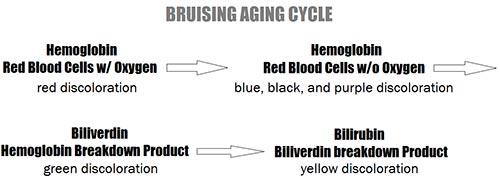Bruises

Bruises are one of the most common skin conditions in the world. Most everyone experiences bruising during their lifetimes, and you may see bruises quite regularly, from young childhood into old age. Bruises are visible signs of trauma to your skin. They are caused by blood trapped underneath your skin. A bruise happens when small blood vessels become crushed, but the injury isn’t bad enough to break the skin. Instead, the tiny vessels pop open and spill inside your body, under the skin. Bruises, also referred to as contusions or by the medical term ecchymosis, can occur on your bones, muscles, or skin. Your New York dermatologist treats those bruises that are most apparent on the skin.
Signs and Symptoms
Bone bruises are the most painful, but skin bruises can cause swelling and pain, especially when touched. Most skin bruises last only about two weeks, although they can last for months. Bruises typically:
- Begin as a red-colored splotch
- Then turn a purple-blue color
- Finally, change into a greenish-yellow hue
- After this progression, your skin returns to its normal color
Anyone from a newborn infant to a centenarian can get a bruise. Many people bruise more easily than others. Why you bruise depends on several factors, including:
- If you have certain medical conditions
- Whether you’re taking blood thinners
- How tough your skin is
- How old you are because as you age, your blood vessels become much more fragile.
Steps to Healing
You can take steps right after an incident to help your bruises heal faster:
- Apply ice to the area to slow down the rate of blood flow.
- Elevate the injured part of your body above your heart to reduce blood pooling.
Because bruising happens so frequently and is such a common mishap, you usually don’t have to see your dermatologist in New York every time you get a bruise. If the discoloration subsides within two weeks, you probably won’t have any lasting complications. You should, however, call your Manhattan dermatologist if you experience:
- Unusually painful swelling
- No noticeable improvements after two weeks
- The tissue under the bruise becomes hardened
- Your joints become stiff
- You’re concerned that you may have broken a bone
- Vison problems for bruises that occur near your eye
- You seem to be bruising more often than usual
- Bruising when you have a blood clotting disorder
- Bruises appearing for no apparent reason
Hand and Arm Bruising
It’s common to get bruises on the backs of your hands and your arms. Your NYC dermatologist sees this kind of regularly bruising, especially as you age. Called solar purpura, actinic purpura, or Bateman’s purpura, these vary from normal bruises that happen after you’ve been hit, bumped into something, or dropped a heavy object on your hands. Actinic purpura bruises seem to pop up for no reason whatsoever.
They don’t hurt either but seem to go through the colorful stages and last longer than two weeks. This bruising is the result of weakened blood vessels. Additionally, the skin usually is damaged from years of sun exposure, which is why the condition is more common among the elderly. The skin is typically thin and papery. Other contributors to actinic purpura include:
- Taking oral or inhaled steroids
- Using blood thinners such as Coumadin or aspirin
- Excessive use of alcohol
Treatment May Pose Difficulties
Hand and arm bruising on flimsy skin can be hard to treat. Your dermatologist in New York City may recommend that you talk to your internist about lowering your blood thinner dosage. A midtown Manhattan dermatologist may prescribe tretinoin or alpha-hydroxy cream that you apply daily. When used in small amounts, the lotions can thicken your skin, so you don’t bruise so easily. Your NYC dermatologist also may suggest various cosmetics to cover up unsightly bruises if you aren’t in a position to change your medicine regimen. Of course, you should do everything you can to protect your hands and arms from even the slightest trauma. Special sleeves are available to give you added protection.
Bruising from Cosmetic Procedures
It’s not uncommon to develop bruising when you visit your Manhattan dermatologist for cosmetic procedures, such as derma fillers or Botox. You may be especially at risk for bruising if you fall into one of the categories above yet enjoy the results you get from cosmetic procedures. Tell your skin doctor about any history you have with bruising so that he can take extra precautions.
Your dermatologist in New York may, for example, choose an injectable filler that’s least likely to cause bruising. You also may be instructed to avoid non-steroidal anti-inflammatory drugs, such as ibuprofen or naproxen, which thin the blood, 10 days before the procedure.
Applying ice before and after getting your cosmetic treatment also may reduce the amount of bruising you experience. Bruising that develops secondary to a cosmetic procedure can be treated with topical or oral arnica, vitamin K, and laser treatment.
Important Reminder: This information is only intended to provide guidance, not definitive medical advice. Please consult dermatologist NYC about your specific condition. Only a trained, experienced board-certified dermatology doctor or pediatric dermatologist could determine an accurate diagnosis and proper treatment.
Locations: Manhattan Dermatology (Upper East Side) 983 Park Ave, Ste 1D1, NY 10028(212) 427-8750 Manhattan Dermatology (Midtown) 56 W 45th St, Ste 819, NY 10036
(212) 889-2402 Manhattan Dermatology (Union Square) 55 W 17th St, Ste 103, NY 10011
(212) 378-9984

